Comparative Analysis of Organizational Behavior in IBM and Apple
VerifiedAdded on 2023/01/10
|18
|5836
|69
Report
AI Summary
This report provides a detailed analysis of organizational behavior within two major tech companies, IBM and Apple. It explores key concepts such as effective and ineffective teams, delving into team development theories like Tuckman's and Belbin's models. The report examines leadership theories including Path Goal Theory and Contingency Theory, evaluating their relevance and application within IBM. Furthermore, it investigates the impact of organizational culture, power, and politics on Apple's operations. Motivational theories are also assessed, providing insights into how behaviors are influenced within the company. The report concludes with a critical evaluation of how these elements combine to influence team success and overall organizational performance, offering a comprehensive overview of organizational behavior principles in practice.
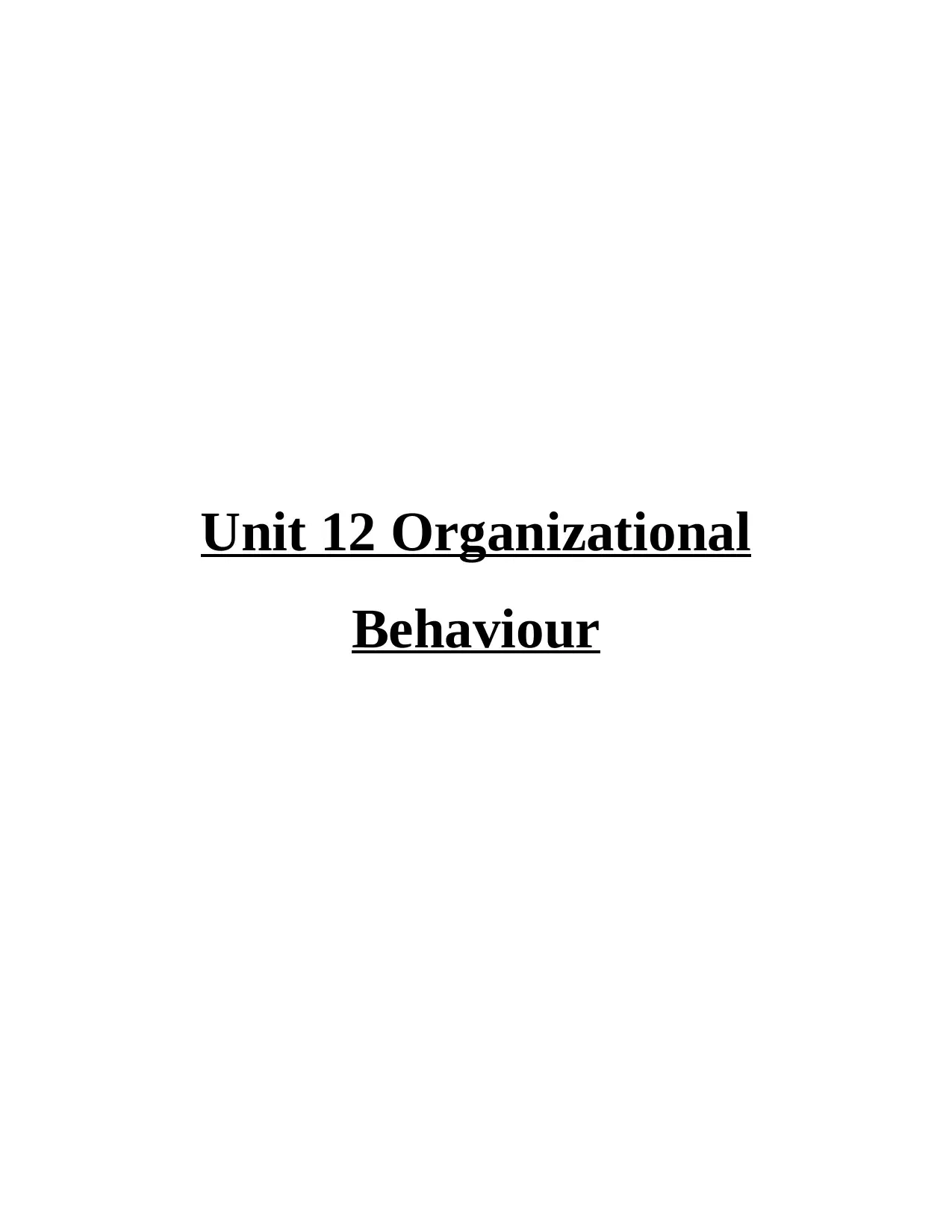
Unit 12 Organizational
Behaviour
Behaviour
Paraphrase This Document
Need a fresh take? Get an instant paraphrase of this document with our AI Paraphraser
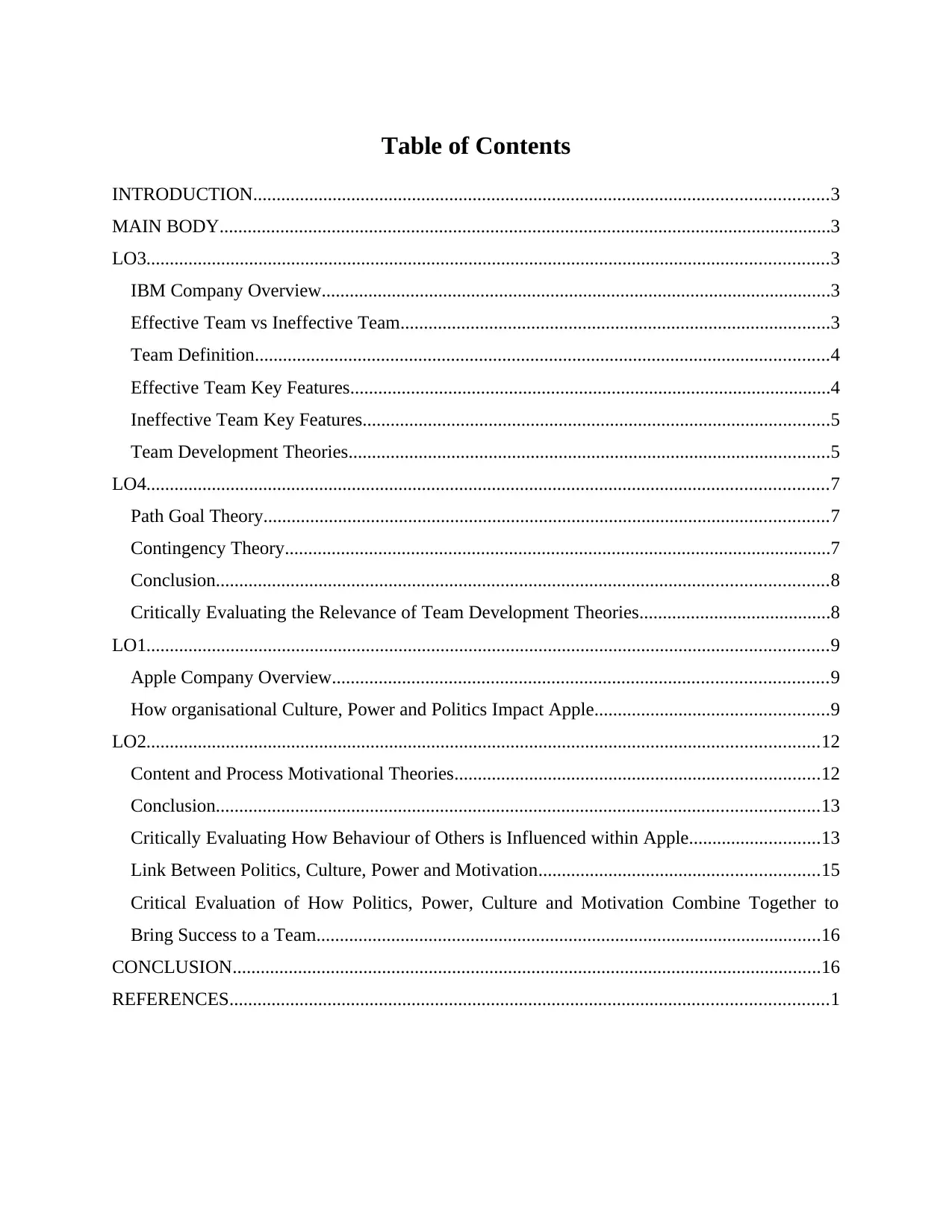
Table of Contents
INTRODUCTION...........................................................................................................................3
MAIN BODY...................................................................................................................................3
LO3..................................................................................................................................................3
IBM Company Overview.............................................................................................................3
Effective Team vs Ineffective Team............................................................................................3
Team Definition...........................................................................................................................4
Effective Team Key Features.......................................................................................................4
Ineffective Team Key Features....................................................................................................5
Team Development Theories.......................................................................................................5
LO4..................................................................................................................................................7
Path Goal Theory.........................................................................................................................7
Contingency Theory.....................................................................................................................7
Conclusion...................................................................................................................................8
Critically Evaluating the Relevance of Team Development Theories.........................................8
LO1..................................................................................................................................................9
Apple Company Overview..........................................................................................................9
How organisational Culture, Power and Politics Impact Apple..................................................9
LO2................................................................................................................................................12
Content and Process Motivational Theories..............................................................................12
Conclusion.................................................................................................................................13
Critically Evaluating How Behaviour of Others is Influenced within Apple............................13
Link Between Politics, Culture, Power and Motivation............................................................15
Critical Evaluation of How Politics, Power, Culture and Motivation Combine Together to
Bring Success to a Team............................................................................................................16
CONCLUSION..............................................................................................................................16
REFERENCES................................................................................................................................1
INTRODUCTION...........................................................................................................................3
MAIN BODY...................................................................................................................................3
LO3..................................................................................................................................................3
IBM Company Overview.............................................................................................................3
Effective Team vs Ineffective Team............................................................................................3
Team Definition...........................................................................................................................4
Effective Team Key Features.......................................................................................................4
Ineffective Team Key Features....................................................................................................5
Team Development Theories.......................................................................................................5
LO4..................................................................................................................................................7
Path Goal Theory.........................................................................................................................7
Contingency Theory.....................................................................................................................7
Conclusion...................................................................................................................................8
Critically Evaluating the Relevance of Team Development Theories.........................................8
LO1..................................................................................................................................................9
Apple Company Overview..........................................................................................................9
How organisational Culture, Power and Politics Impact Apple..................................................9
LO2................................................................................................................................................12
Content and Process Motivational Theories..............................................................................12
Conclusion.................................................................................................................................13
Critically Evaluating How Behaviour of Others is Influenced within Apple............................13
Link Between Politics, Culture, Power and Motivation............................................................15
Critical Evaluation of How Politics, Power, Culture and Motivation Combine Together to
Bring Success to a Team............................................................................................................16
CONCLUSION..............................................................................................................................16
REFERENCES................................................................................................................................1
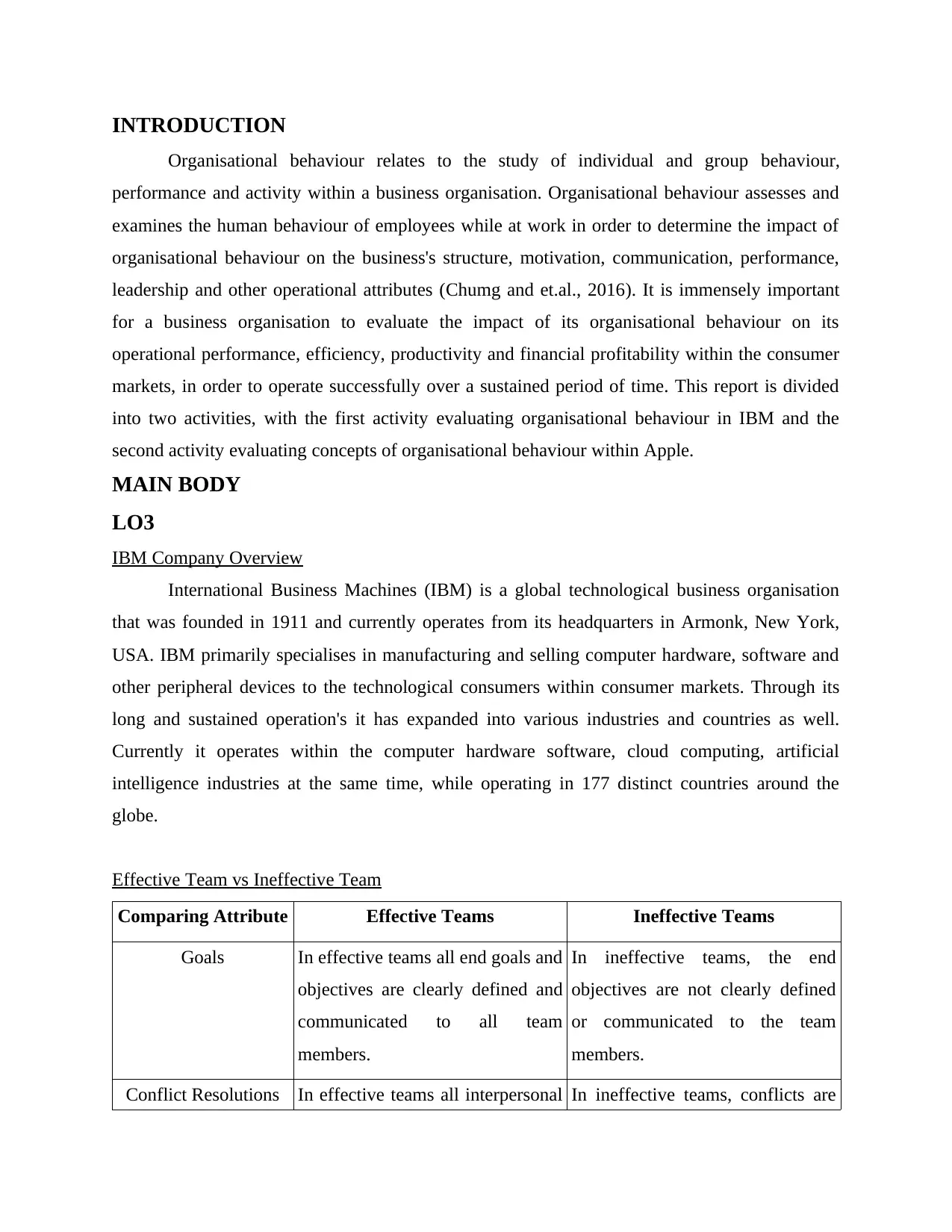
INTRODUCTION
Organisational behaviour relates to the study of individual and group behaviour,
performance and activity within a business organisation. Organisational behaviour assesses and
examines the human behaviour of employees while at work in order to determine the impact of
organisational behaviour on the business's structure, motivation, communication, performance,
leadership and other operational attributes (Chumg and et.al., 2016). It is immensely important
for a business organisation to evaluate the impact of its organisational behaviour on its
operational performance, efficiency, productivity and financial profitability within the consumer
markets, in order to operate successfully over a sustained period of time. This report is divided
into two activities, with the first activity evaluating organisational behaviour in IBM and the
second activity evaluating concepts of organisational behaviour within Apple.
MAIN BODY
LO3
IBM Company Overview
International Business Machines (IBM) is a global technological business organisation
that was founded in 1911 and currently operates from its headquarters in Armonk, New York,
USA. IBM primarily specialises in manufacturing and selling computer hardware, software and
other peripheral devices to the technological consumers within consumer markets. Through its
long and sustained operation's it has expanded into various industries and countries as well.
Currently it operates within the computer hardware software, cloud computing, artificial
intelligence industries at the same time, while operating in 177 distinct countries around the
globe.
Effective Team vs Ineffective Team
Comparing Attribute Effective Teams Ineffective Teams
Goals In effective teams all end goals and
objectives are clearly defined and
communicated to all team
members.
In ineffective teams, the end
objectives are not clearly defined
or communicated to the team
members.
Conflict Resolutions In effective teams all interpersonal In ineffective teams, conflicts are
Organisational behaviour relates to the study of individual and group behaviour,
performance and activity within a business organisation. Organisational behaviour assesses and
examines the human behaviour of employees while at work in order to determine the impact of
organisational behaviour on the business's structure, motivation, communication, performance,
leadership and other operational attributes (Chumg and et.al., 2016). It is immensely important
for a business organisation to evaluate the impact of its organisational behaviour on its
operational performance, efficiency, productivity and financial profitability within the consumer
markets, in order to operate successfully over a sustained period of time. This report is divided
into two activities, with the first activity evaluating organisational behaviour in IBM and the
second activity evaluating concepts of organisational behaviour within Apple.
MAIN BODY
LO3
IBM Company Overview
International Business Machines (IBM) is a global technological business organisation
that was founded in 1911 and currently operates from its headquarters in Armonk, New York,
USA. IBM primarily specialises in manufacturing and selling computer hardware, software and
other peripheral devices to the technological consumers within consumer markets. Through its
long and sustained operation's it has expanded into various industries and countries as well.
Currently it operates within the computer hardware software, cloud computing, artificial
intelligence industries at the same time, while operating in 177 distinct countries around the
globe.
Effective Team vs Ineffective Team
Comparing Attribute Effective Teams Ineffective Teams
Goals In effective teams all end goals and
objectives are clearly defined and
communicated to all team
members.
In ineffective teams, the end
objectives are not clearly defined
or communicated to the team
members.
Conflict Resolutions In effective teams all interpersonal In ineffective teams, conflicts are
⊘ This is a preview!⊘
Do you want full access?
Subscribe today to unlock all pages.

Trusted by 1+ million students worldwide
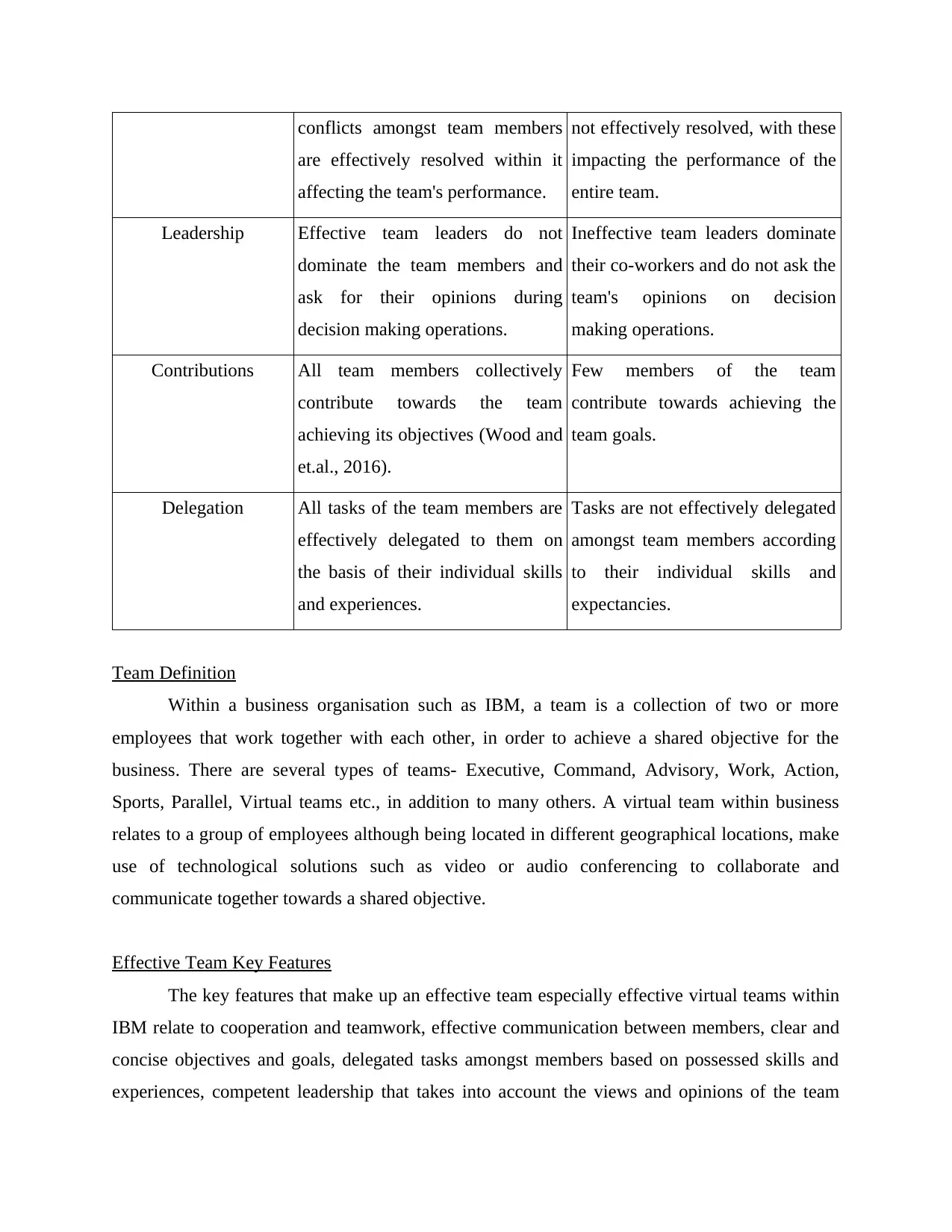
conflicts amongst team members
are effectively resolved within it
affecting the team's performance.
not effectively resolved, with these
impacting the performance of the
entire team.
Leadership Effective team leaders do not
dominate the team members and
ask for their opinions during
decision making operations.
Ineffective team leaders dominate
their co-workers and do not ask the
team's opinions on decision
making operations.
Contributions All team members collectively
contribute towards the team
achieving its objectives (Wood and
et.al., 2016).
Few members of the team
contribute towards achieving the
team goals.
Delegation All tasks of the team members are
effectively delegated to them on
the basis of their individual skills
and experiences.
Tasks are not effectively delegated
amongst team members according
to their individual skills and
expectancies.
Team Definition
Within a business organisation such as IBM, a team is a collection of two or more
employees that work together with each other, in order to achieve a shared objective for the
business. There are several types of teams- Executive, Command, Advisory, Work, Action,
Sports, Parallel, Virtual teams etc., in addition to many others. A virtual team within business
relates to a group of employees although being located in different geographical locations, make
use of technological solutions such as video or audio conferencing to collaborate and
communicate together towards a shared objective.
Effective Team Key Features
The key features that make up an effective team especially effective virtual teams within
IBM relate to cooperation and teamwork, effective communication between members, clear and
concise objectives and goals, delegated tasks amongst members based on possessed skills and
experiences, competent leadership that takes into account the views and opinions of the team
are effectively resolved within it
affecting the team's performance.
not effectively resolved, with these
impacting the performance of the
entire team.
Leadership Effective team leaders do not
dominate the team members and
ask for their opinions during
decision making operations.
Ineffective team leaders dominate
their co-workers and do not ask the
team's opinions on decision
making operations.
Contributions All team members collectively
contribute towards the team
achieving its objectives (Wood and
et.al., 2016).
Few members of the team
contribute towards achieving the
team goals.
Delegation All tasks of the team members are
effectively delegated to them on
the basis of their individual skills
and experiences.
Tasks are not effectively delegated
amongst team members according
to their individual skills and
expectancies.
Team Definition
Within a business organisation such as IBM, a team is a collection of two or more
employees that work together with each other, in order to achieve a shared objective for the
business. There are several types of teams- Executive, Command, Advisory, Work, Action,
Sports, Parallel, Virtual teams etc., in addition to many others. A virtual team within business
relates to a group of employees although being located in different geographical locations, make
use of technological solutions such as video or audio conferencing to collaborate and
communicate together towards a shared objective.
Effective Team Key Features
The key features that make up an effective team especially effective virtual teams within
IBM relate to cooperation and teamwork, effective communication between members, clear and
concise objectives and goals, delegated tasks amongst members based on possessed skills and
experiences, competent leadership that takes into account the views and opinions of the team
Paraphrase This Document
Need a fresh take? Get an instant paraphrase of this document with our AI Paraphraser
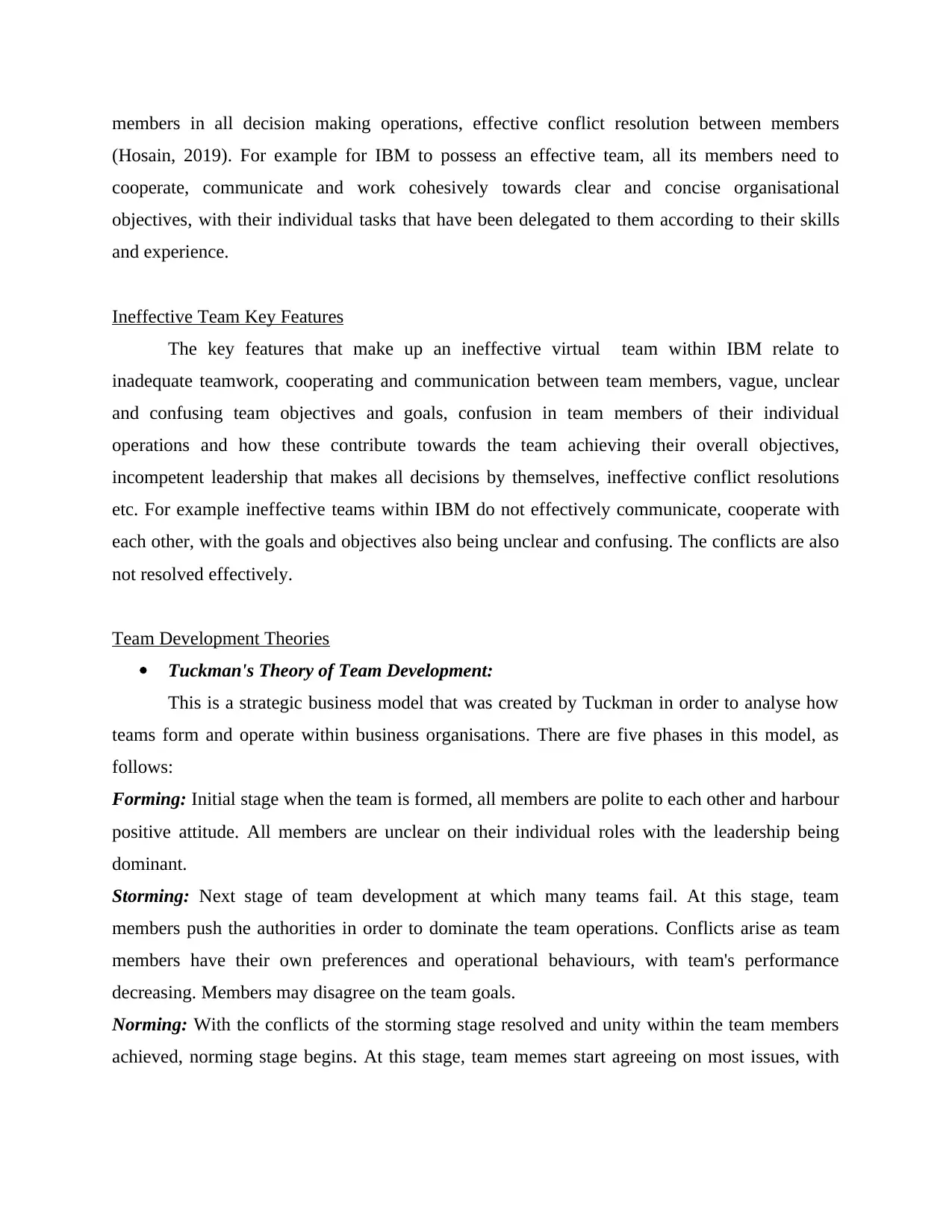
members in all decision making operations, effective conflict resolution between members
(Hosain, 2019). For example for IBM to possess an effective team, all its members need to
cooperate, communicate and work cohesively towards clear and concise organisational
objectives, with their individual tasks that have been delegated to them according to their skills
and experience.
Ineffective Team Key Features
The key features that make up an ineffective virtual team within IBM relate to
inadequate teamwork, cooperating and communication between team members, vague, unclear
and confusing team objectives and goals, confusion in team members of their individual
operations and how these contribute towards the team achieving their overall objectives,
incompetent leadership that makes all decisions by themselves, ineffective conflict resolutions
etc. For example ineffective teams within IBM do not effectively communicate, cooperate with
each other, with the goals and objectives also being unclear and confusing. The conflicts are also
not resolved effectively.
Team Development Theories
Tuckman's Theory of Team Development:
This is a strategic business model that was created by Tuckman in order to analyse how
teams form and operate within business organisations. There are five phases in this model, as
follows:
Forming: Initial stage when the team is formed, all members are polite to each other and harbour
positive attitude. All members are unclear on their individual roles with the leadership being
dominant.
Storming: Next stage of team development at which many teams fail. At this stage, team
members push the authorities in order to dominate the team operations. Conflicts arise as team
members have their own preferences and operational behaviours, with team's performance
decreasing. Members may disagree on the team goals.
Norming: With the conflicts of the storming stage resolved and unity within the team members
achieved, norming stage begins. At this stage, team memes start agreeing on most issues, with
(Hosain, 2019). For example for IBM to possess an effective team, all its members need to
cooperate, communicate and work cohesively towards clear and concise organisational
objectives, with their individual tasks that have been delegated to them according to their skills
and experience.
Ineffective Team Key Features
The key features that make up an ineffective virtual team within IBM relate to
inadequate teamwork, cooperating and communication between team members, vague, unclear
and confusing team objectives and goals, confusion in team members of their individual
operations and how these contribute towards the team achieving their overall objectives,
incompetent leadership that makes all decisions by themselves, ineffective conflict resolutions
etc. For example ineffective teams within IBM do not effectively communicate, cooperate with
each other, with the goals and objectives also being unclear and confusing. The conflicts are also
not resolved effectively.
Team Development Theories
Tuckman's Theory of Team Development:
This is a strategic business model that was created by Tuckman in order to analyse how
teams form and operate within business organisations. There are five phases in this model, as
follows:
Forming: Initial stage when the team is formed, all members are polite to each other and harbour
positive attitude. All members are unclear on their individual roles with the leadership being
dominant.
Storming: Next stage of team development at which many teams fail. At this stage, team
members push the authorities in order to dominate the team operations. Conflicts arise as team
members have their own preferences and operational behaviours, with team's performance
decreasing. Members may disagree on the team goals.
Norming: With the conflicts of the storming stage resolved and unity within the team members
achieved, norming stage begins. At this stage, team memes start agreeing on most issues, with
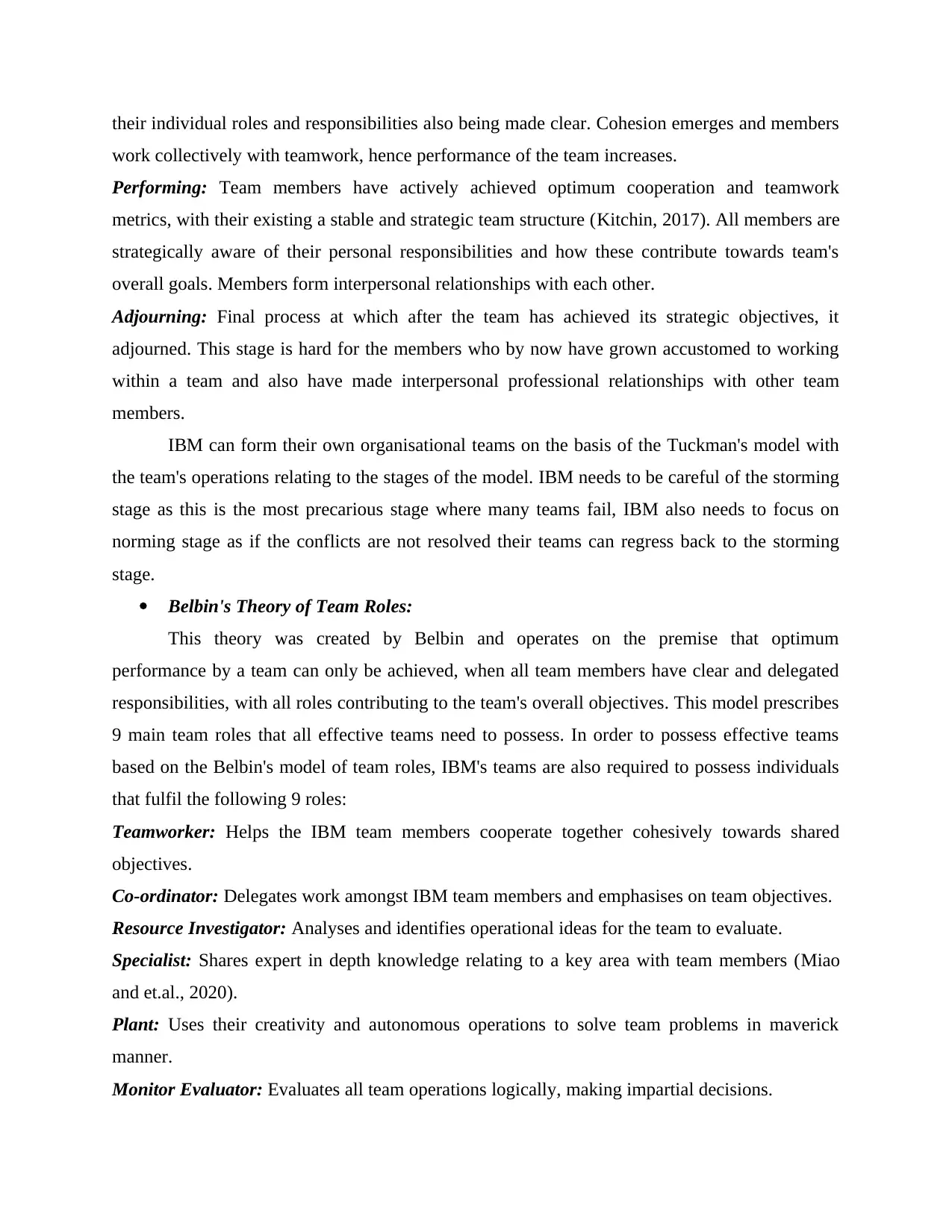
their individual roles and responsibilities also being made clear. Cohesion emerges and members
work collectively with teamwork, hence performance of the team increases.
Performing: Team members have actively achieved optimum cooperation and teamwork
metrics, with their existing a stable and strategic team structure (Kitchin, 2017). All members are
strategically aware of their personal responsibilities and how these contribute towards team's
overall goals. Members form interpersonal relationships with each other.
Adjourning: Final process at which after the team has achieved its strategic objectives, it
adjourned. This stage is hard for the members who by now have grown accustomed to working
within a team and also have made interpersonal professional relationships with other team
members.
IBM can form their own organisational teams on the basis of the Tuckman's model with
the team's operations relating to the stages of the model. IBM needs to be careful of the storming
stage as this is the most precarious stage where many teams fail, IBM also needs to focus on
norming stage as if the conflicts are not resolved their teams can regress back to the storming
stage.
Belbin's Theory of Team Roles:
This theory was created by Belbin and operates on the premise that optimum
performance by a team can only be achieved, when all team members have clear and delegated
responsibilities, with all roles contributing to the team's overall objectives. This model prescribes
9 main team roles that all effective teams need to possess. In order to possess effective teams
based on the Belbin's model of team roles, IBM's teams are also required to possess individuals
that fulfil the following 9 roles:
Teamworker: Helps the IBM team members cooperate together cohesively towards shared
objectives.
Co-ordinator: Delegates work amongst IBM team members and emphasises on team objectives.
Resource Investigator: Analyses and identifies operational ideas for the team to evaluate.
Specialist: Shares expert in depth knowledge relating to a key area with team members (Miao
and et.al., 2020).
Plant: Uses their creativity and autonomous operations to solve team problems in maverick
manner.
Monitor Evaluator: Evaluates all team operations logically, making impartial decisions.
work collectively with teamwork, hence performance of the team increases.
Performing: Team members have actively achieved optimum cooperation and teamwork
metrics, with their existing a stable and strategic team structure (Kitchin, 2017). All members are
strategically aware of their personal responsibilities and how these contribute towards team's
overall goals. Members form interpersonal relationships with each other.
Adjourning: Final process at which after the team has achieved its strategic objectives, it
adjourned. This stage is hard for the members who by now have grown accustomed to working
within a team and also have made interpersonal professional relationships with other team
members.
IBM can form their own organisational teams on the basis of the Tuckman's model with
the team's operations relating to the stages of the model. IBM needs to be careful of the storming
stage as this is the most precarious stage where many teams fail, IBM also needs to focus on
norming stage as if the conflicts are not resolved their teams can regress back to the storming
stage.
Belbin's Theory of Team Roles:
This theory was created by Belbin and operates on the premise that optimum
performance by a team can only be achieved, when all team members have clear and delegated
responsibilities, with all roles contributing to the team's overall objectives. This model prescribes
9 main team roles that all effective teams need to possess. In order to possess effective teams
based on the Belbin's model of team roles, IBM's teams are also required to possess individuals
that fulfil the following 9 roles:
Teamworker: Helps the IBM team members cooperate together cohesively towards shared
objectives.
Co-ordinator: Delegates work amongst IBM team members and emphasises on team objectives.
Resource Investigator: Analyses and identifies operational ideas for the team to evaluate.
Specialist: Shares expert in depth knowledge relating to a key area with team members (Miao
and et.al., 2020).
Plant: Uses their creativity and autonomous operations to solve team problems in maverick
manner.
Monitor Evaluator: Evaluates all team operations logically, making impartial decisions.
⊘ This is a preview!⊘
Do you want full access?
Subscribe today to unlock all pages.

Trusted by 1+ million students worldwide
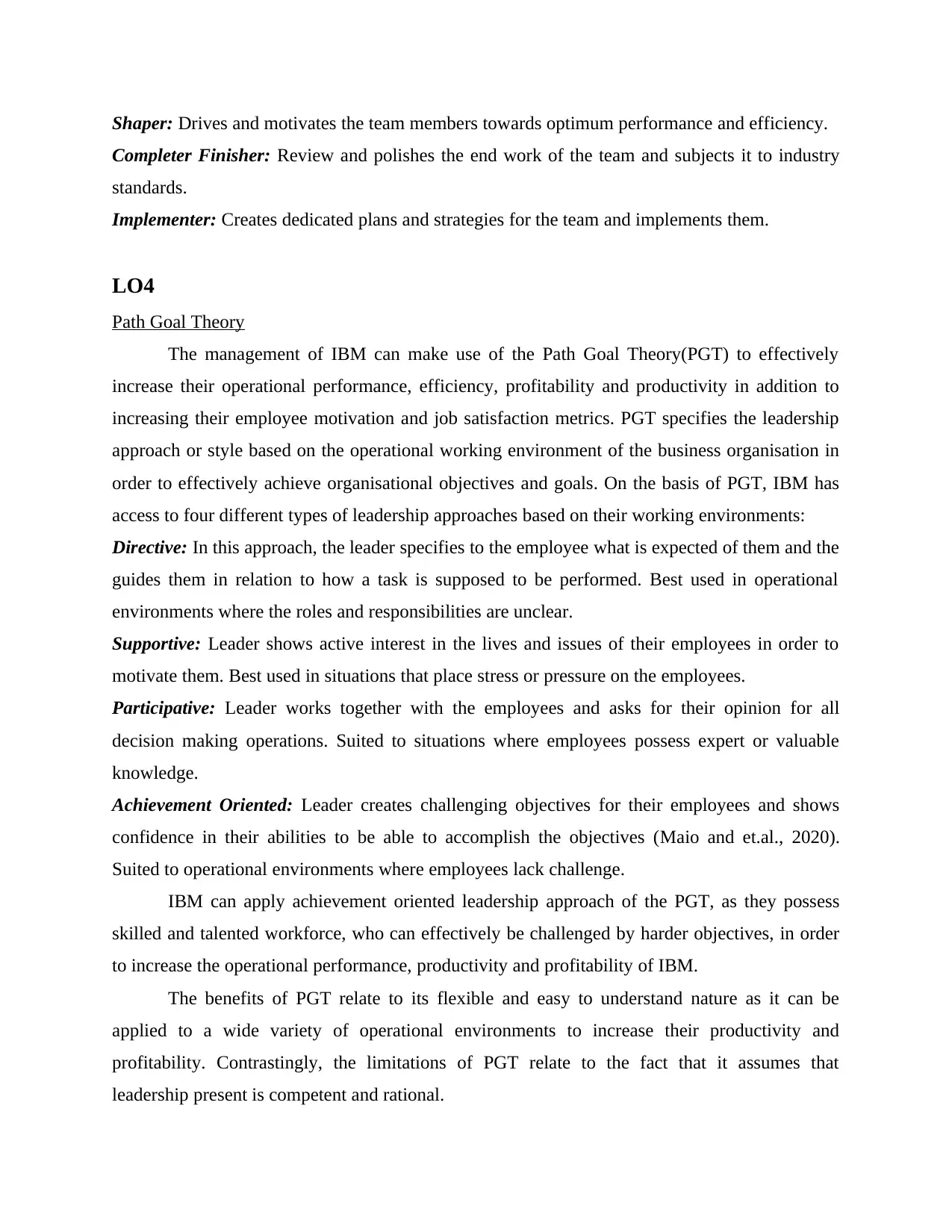
Shaper: Drives and motivates the team members towards optimum performance and efficiency.
Completer Finisher: Review and polishes the end work of the team and subjects it to industry
standards.
Implementer: Creates dedicated plans and strategies for the team and implements them.
LO4
Path Goal Theory
The management of IBM can make use of the Path Goal Theory(PGT) to effectively
increase their operational performance, efficiency, profitability and productivity in addition to
increasing their employee motivation and job satisfaction metrics. PGT specifies the leadership
approach or style based on the operational working environment of the business organisation in
order to effectively achieve organisational objectives and goals. On the basis of PGT, IBM has
access to four different types of leadership approaches based on their working environments:
Directive: In this approach, the leader specifies to the employee what is expected of them and the
guides them in relation to how a task is supposed to be performed. Best used in operational
environments where the roles and responsibilities are unclear.
Supportive: Leader shows active interest in the lives and issues of their employees in order to
motivate them. Best used in situations that place stress or pressure on the employees.
Participative: Leader works together with the employees and asks for their opinion for all
decision making operations. Suited to situations where employees possess expert or valuable
knowledge.
Achievement Oriented: Leader creates challenging objectives for their employees and shows
confidence in their abilities to be able to accomplish the objectives (Maio and et.al., 2020).
Suited to operational environments where employees lack challenge.
IBM can apply achievement oriented leadership approach of the PGT, as they possess
skilled and talented workforce, who can effectively be challenged by harder objectives, in order
to increase the operational performance, productivity and profitability of IBM.
The benefits of PGT relate to its flexible and easy to understand nature as it can be
applied to a wide variety of operational environments to increase their productivity and
profitability. Contrastingly, the limitations of PGT relate to the fact that it assumes that
leadership present is competent and rational.
Completer Finisher: Review and polishes the end work of the team and subjects it to industry
standards.
Implementer: Creates dedicated plans and strategies for the team and implements them.
LO4
Path Goal Theory
The management of IBM can make use of the Path Goal Theory(PGT) to effectively
increase their operational performance, efficiency, profitability and productivity in addition to
increasing their employee motivation and job satisfaction metrics. PGT specifies the leadership
approach or style based on the operational working environment of the business organisation in
order to effectively achieve organisational objectives and goals. On the basis of PGT, IBM has
access to four different types of leadership approaches based on their working environments:
Directive: In this approach, the leader specifies to the employee what is expected of them and the
guides them in relation to how a task is supposed to be performed. Best used in operational
environments where the roles and responsibilities are unclear.
Supportive: Leader shows active interest in the lives and issues of their employees in order to
motivate them. Best used in situations that place stress or pressure on the employees.
Participative: Leader works together with the employees and asks for their opinion for all
decision making operations. Suited to situations where employees possess expert or valuable
knowledge.
Achievement Oriented: Leader creates challenging objectives for their employees and shows
confidence in their abilities to be able to accomplish the objectives (Maio and et.al., 2020).
Suited to operational environments where employees lack challenge.
IBM can apply achievement oriented leadership approach of the PGT, as they possess
skilled and talented workforce, who can effectively be challenged by harder objectives, in order
to increase the operational performance, productivity and profitability of IBM.
The benefits of PGT relate to its flexible and easy to understand nature as it can be
applied to a wide variety of operational environments to increase their productivity and
profitability. Contrastingly, the limitations of PGT relate to the fact that it assumes that
leadership present is competent and rational.
Paraphrase This Document
Need a fresh take? Get an instant paraphrase of this document with our AI Paraphraser
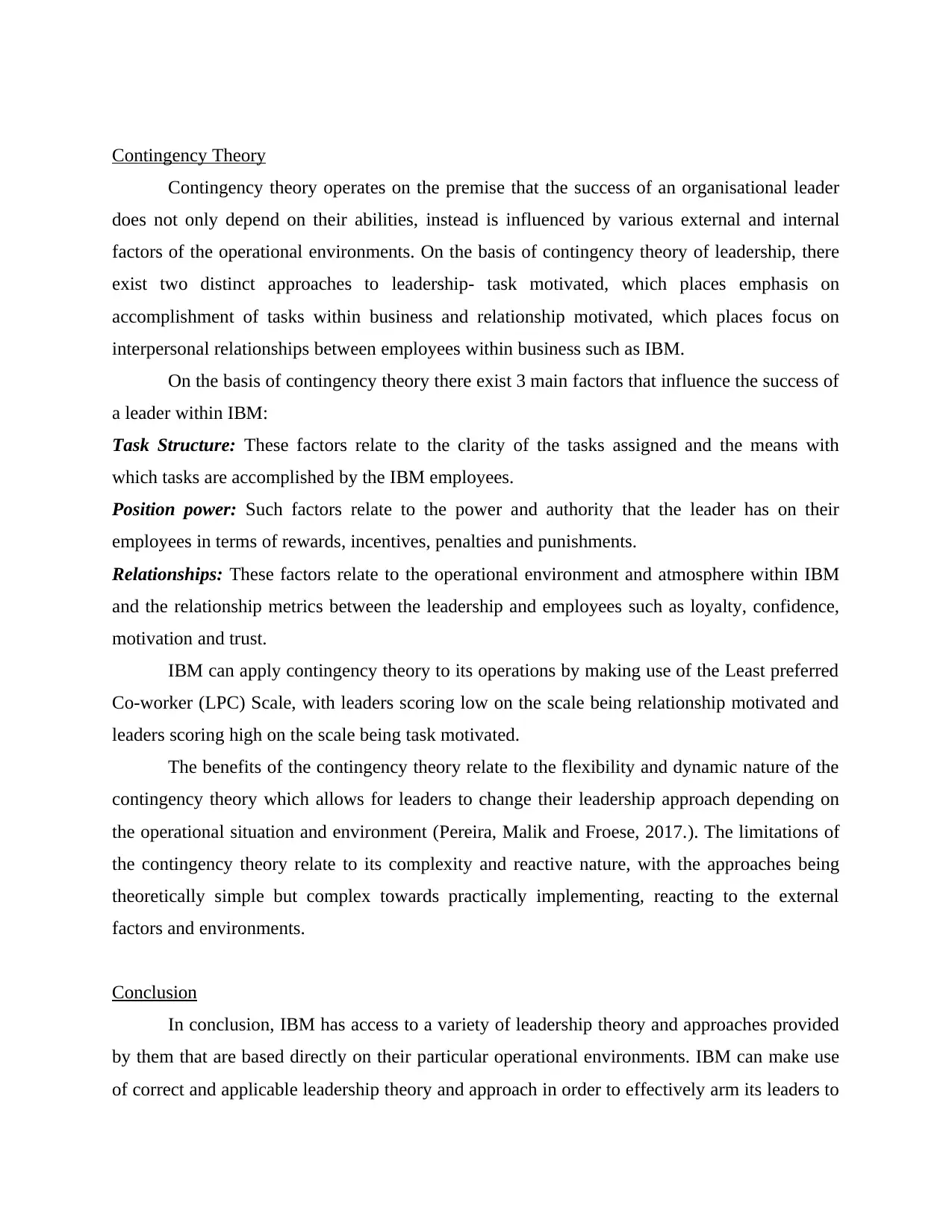
Contingency Theory
Contingency theory operates on the premise that the success of an organisational leader
does not only depend on their abilities, instead is influenced by various external and internal
factors of the operational environments. On the basis of contingency theory of leadership, there
exist two distinct approaches to leadership- task motivated, which places emphasis on
accomplishment of tasks within business and relationship motivated, which places focus on
interpersonal relationships between employees within business such as IBM.
On the basis of contingency theory there exist 3 main factors that influence the success of
a leader within IBM:
Task Structure: These factors relate to the clarity of the tasks assigned and the means with
which tasks are accomplished by the IBM employees.
Position power: Such factors relate to the power and authority that the leader has on their
employees in terms of rewards, incentives, penalties and punishments.
Relationships: These factors relate to the operational environment and atmosphere within IBM
and the relationship metrics between the leadership and employees such as loyalty, confidence,
motivation and trust.
IBM can apply contingency theory to its operations by making use of the Least preferred
Co-worker (LPC) Scale, with leaders scoring low on the scale being relationship motivated and
leaders scoring high on the scale being task motivated.
The benefits of the contingency theory relate to the flexibility and dynamic nature of the
contingency theory which allows for leaders to change their leadership approach depending on
the operational situation and environment (Pereira, Malik and Froese, 2017.). The limitations of
the contingency theory relate to its complexity and reactive nature, with the approaches being
theoretically simple but complex towards practically implementing, reacting to the external
factors and environments.
Conclusion
In conclusion, IBM has access to a variety of leadership theory and approaches provided
by them that are based directly on their particular operational environments. IBM can make use
of correct and applicable leadership theory and approach in order to effectively arm its leaders to
Contingency theory operates on the premise that the success of an organisational leader
does not only depend on their abilities, instead is influenced by various external and internal
factors of the operational environments. On the basis of contingency theory of leadership, there
exist two distinct approaches to leadership- task motivated, which places emphasis on
accomplishment of tasks within business and relationship motivated, which places focus on
interpersonal relationships between employees within business such as IBM.
On the basis of contingency theory there exist 3 main factors that influence the success of
a leader within IBM:
Task Structure: These factors relate to the clarity of the tasks assigned and the means with
which tasks are accomplished by the IBM employees.
Position power: Such factors relate to the power and authority that the leader has on their
employees in terms of rewards, incentives, penalties and punishments.
Relationships: These factors relate to the operational environment and atmosphere within IBM
and the relationship metrics between the leadership and employees such as loyalty, confidence,
motivation and trust.
IBM can apply contingency theory to its operations by making use of the Least preferred
Co-worker (LPC) Scale, with leaders scoring low on the scale being relationship motivated and
leaders scoring high on the scale being task motivated.
The benefits of the contingency theory relate to the flexibility and dynamic nature of the
contingency theory which allows for leaders to change their leadership approach depending on
the operational situation and environment (Pereira, Malik and Froese, 2017.). The limitations of
the contingency theory relate to its complexity and reactive nature, with the approaches being
theoretically simple but complex towards practically implementing, reacting to the external
factors and environments.
Conclusion
In conclusion, IBM has access to a variety of leadership theory and approaches provided
by them that are based directly on their particular operational environments. IBM can make use
of correct and applicable leadership theory and approach in order to effectively arm its leaders to
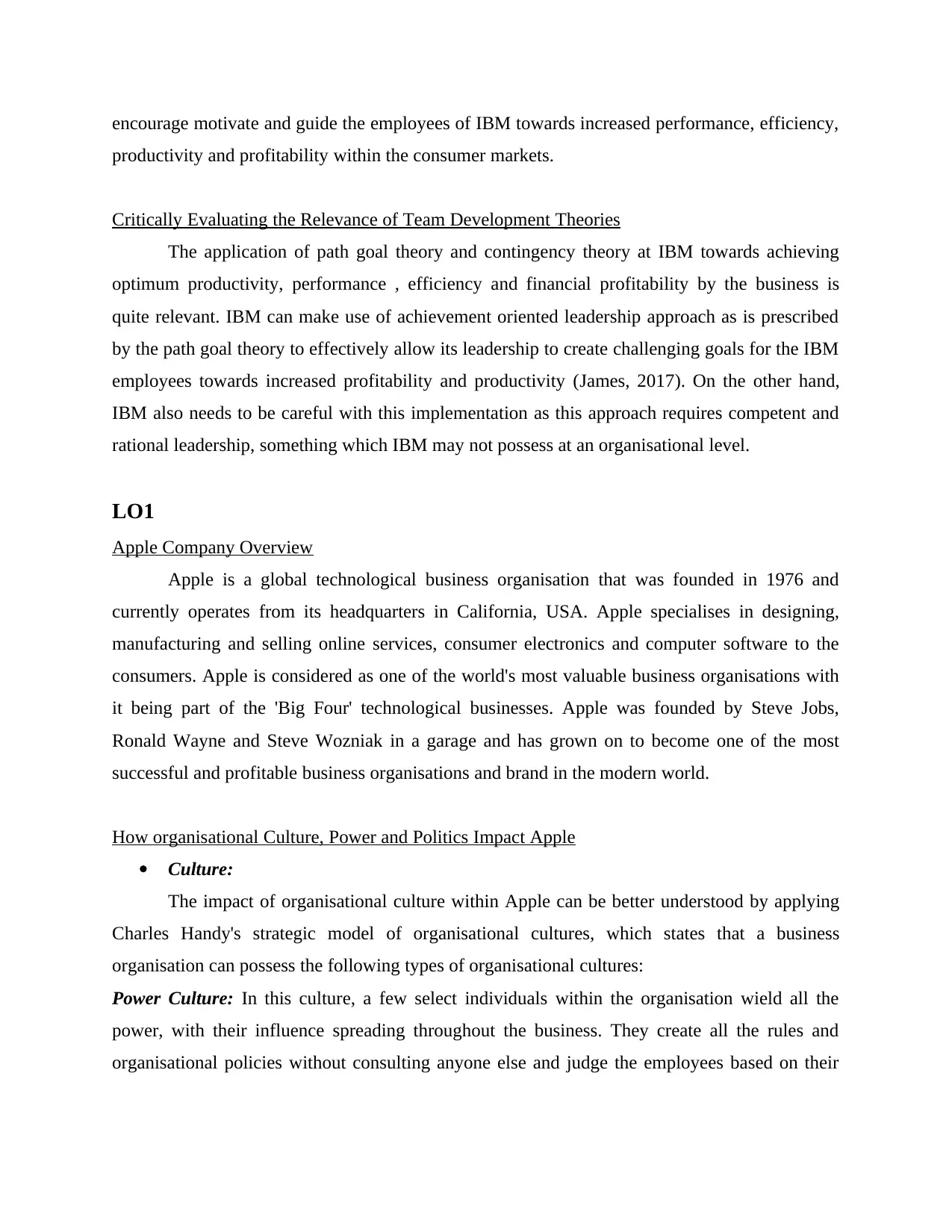
encourage motivate and guide the employees of IBM towards increased performance, efficiency,
productivity and profitability within the consumer markets.
Critically Evaluating the Relevance of Team Development Theories
The application of path goal theory and contingency theory at IBM towards achieving
optimum productivity, performance , efficiency and financial profitability by the business is
quite relevant. IBM can make use of achievement oriented leadership approach as is prescribed
by the path goal theory to effectively allow its leadership to create challenging goals for the IBM
employees towards increased profitability and productivity (James, 2017). On the other hand,
IBM also needs to be careful with this implementation as this approach requires competent and
rational leadership, something which IBM may not possess at an organisational level.
LO1
Apple Company Overview
Apple is a global technological business organisation that was founded in 1976 and
currently operates from its headquarters in California, USA. Apple specialises in designing,
manufacturing and selling online services, consumer electronics and computer software to the
consumers. Apple is considered as one of the world's most valuable business organisations with
it being part of the 'Big Four' technological businesses. Apple was founded by Steve Jobs,
Ronald Wayne and Steve Wozniak in a garage and has grown on to become one of the most
successful and profitable business organisations and brand in the modern world.
How organisational Culture, Power and Politics Impact Apple
Culture:
The impact of organisational culture within Apple can be better understood by applying
Charles Handy's strategic model of organisational cultures, which states that a business
organisation can possess the following types of organisational cultures:
Power Culture: In this culture, a few select individuals within the organisation wield all the
power, with their influence spreading throughout the business. They create all the rules and
organisational policies without consulting anyone else and judge the employees based on their
productivity and profitability within the consumer markets.
Critically Evaluating the Relevance of Team Development Theories
The application of path goal theory and contingency theory at IBM towards achieving
optimum productivity, performance , efficiency and financial profitability by the business is
quite relevant. IBM can make use of achievement oriented leadership approach as is prescribed
by the path goal theory to effectively allow its leadership to create challenging goals for the IBM
employees towards increased profitability and productivity (James, 2017). On the other hand,
IBM also needs to be careful with this implementation as this approach requires competent and
rational leadership, something which IBM may not possess at an organisational level.
LO1
Apple Company Overview
Apple is a global technological business organisation that was founded in 1976 and
currently operates from its headquarters in California, USA. Apple specialises in designing,
manufacturing and selling online services, consumer electronics and computer software to the
consumers. Apple is considered as one of the world's most valuable business organisations with
it being part of the 'Big Four' technological businesses. Apple was founded by Steve Jobs,
Ronald Wayne and Steve Wozniak in a garage and has grown on to become one of the most
successful and profitable business organisations and brand in the modern world.
How organisational Culture, Power and Politics Impact Apple
Culture:
The impact of organisational culture within Apple can be better understood by applying
Charles Handy's strategic model of organisational cultures, which states that a business
organisation can possess the following types of organisational cultures:
Power Culture: In this culture, a few select individuals within the organisation wield all the
power, with their influence spreading throughout the business. They create all the rules and
organisational policies without consulting anyone else and judge the employees based on their
⊘ This is a preview!⊘
Do you want full access?
Subscribe today to unlock all pages.

Trusted by 1+ million students worldwide
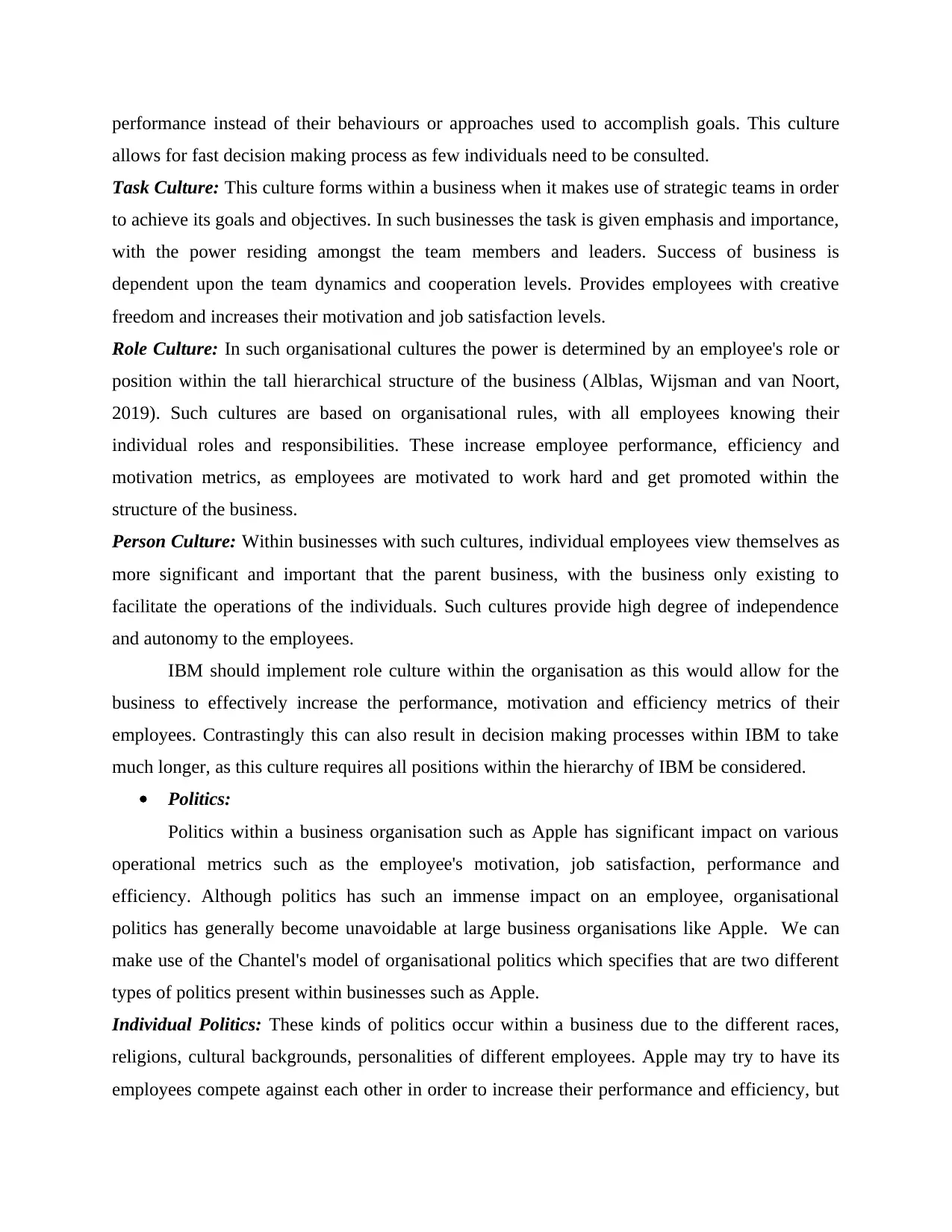
performance instead of their behaviours or approaches used to accomplish goals. This culture
allows for fast decision making process as few individuals need to be consulted.
Task Culture: This culture forms within a business when it makes use of strategic teams in order
to achieve its goals and objectives. In such businesses the task is given emphasis and importance,
with the power residing amongst the team members and leaders. Success of business is
dependent upon the team dynamics and cooperation levels. Provides employees with creative
freedom and increases their motivation and job satisfaction levels.
Role Culture: In such organisational cultures the power is determined by an employee's role or
position within the tall hierarchical structure of the business (Alblas, Wijsman and van Noort,
2019). Such cultures are based on organisational rules, with all employees knowing their
individual roles and responsibilities. These increase employee performance, efficiency and
motivation metrics, as employees are motivated to work hard and get promoted within the
structure of the business.
Person Culture: Within businesses with such cultures, individual employees view themselves as
more significant and important that the parent business, with the business only existing to
facilitate the operations of the individuals. Such cultures provide high degree of independence
and autonomy to the employees.
IBM should implement role culture within the organisation as this would allow for the
business to effectively increase the performance, motivation and efficiency metrics of their
employees. Contrastingly this can also result in decision making processes within IBM to take
much longer, as this culture requires all positions within the hierarchy of IBM be considered.
Politics:
Politics within a business organisation such as Apple has significant impact on various
operational metrics such as the employee's motivation, job satisfaction, performance and
efficiency. Although politics has such an immense impact on an employee, organisational
politics has generally become unavoidable at large business organisations like Apple. We can
make use of the Chantel's model of organisational politics which specifies that are two different
types of politics present within businesses such as Apple.
Individual Politics: These kinds of politics occur within a business due to the different races,
religions, cultural backgrounds, personalities of different employees. Apple may try to have its
employees compete against each other in order to increase their performance and efficiency, but
allows for fast decision making process as few individuals need to be consulted.
Task Culture: This culture forms within a business when it makes use of strategic teams in order
to achieve its goals and objectives. In such businesses the task is given emphasis and importance,
with the power residing amongst the team members and leaders. Success of business is
dependent upon the team dynamics and cooperation levels. Provides employees with creative
freedom and increases their motivation and job satisfaction levels.
Role Culture: In such organisational cultures the power is determined by an employee's role or
position within the tall hierarchical structure of the business (Alblas, Wijsman and van Noort,
2019). Such cultures are based on organisational rules, with all employees knowing their
individual roles and responsibilities. These increase employee performance, efficiency and
motivation metrics, as employees are motivated to work hard and get promoted within the
structure of the business.
Person Culture: Within businesses with such cultures, individual employees view themselves as
more significant and important that the parent business, with the business only existing to
facilitate the operations of the individuals. Such cultures provide high degree of independence
and autonomy to the employees.
IBM should implement role culture within the organisation as this would allow for the
business to effectively increase the performance, motivation and efficiency metrics of their
employees. Contrastingly this can also result in decision making processes within IBM to take
much longer, as this culture requires all positions within the hierarchy of IBM be considered.
Politics:
Politics within a business organisation such as Apple has significant impact on various
operational metrics such as the employee's motivation, job satisfaction, performance and
efficiency. Although politics has such an immense impact on an employee, organisational
politics has generally become unavoidable at large business organisations like Apple. We can
make use of the Chantel's model of organisational politics which specifies that are two different
types of politics present within businesses such as Apple.
Individual Politics: These kinds of politics occur within a business due to the different races,
religions, cultural backgrounds, personalities of different employees. Apple may try to have its
employees compete against each other in order to increase their performance and efficiency, but
Paraphrase This Document
Need a fresh take? Get an instant paraphrase of this document with our AI Paraphraser
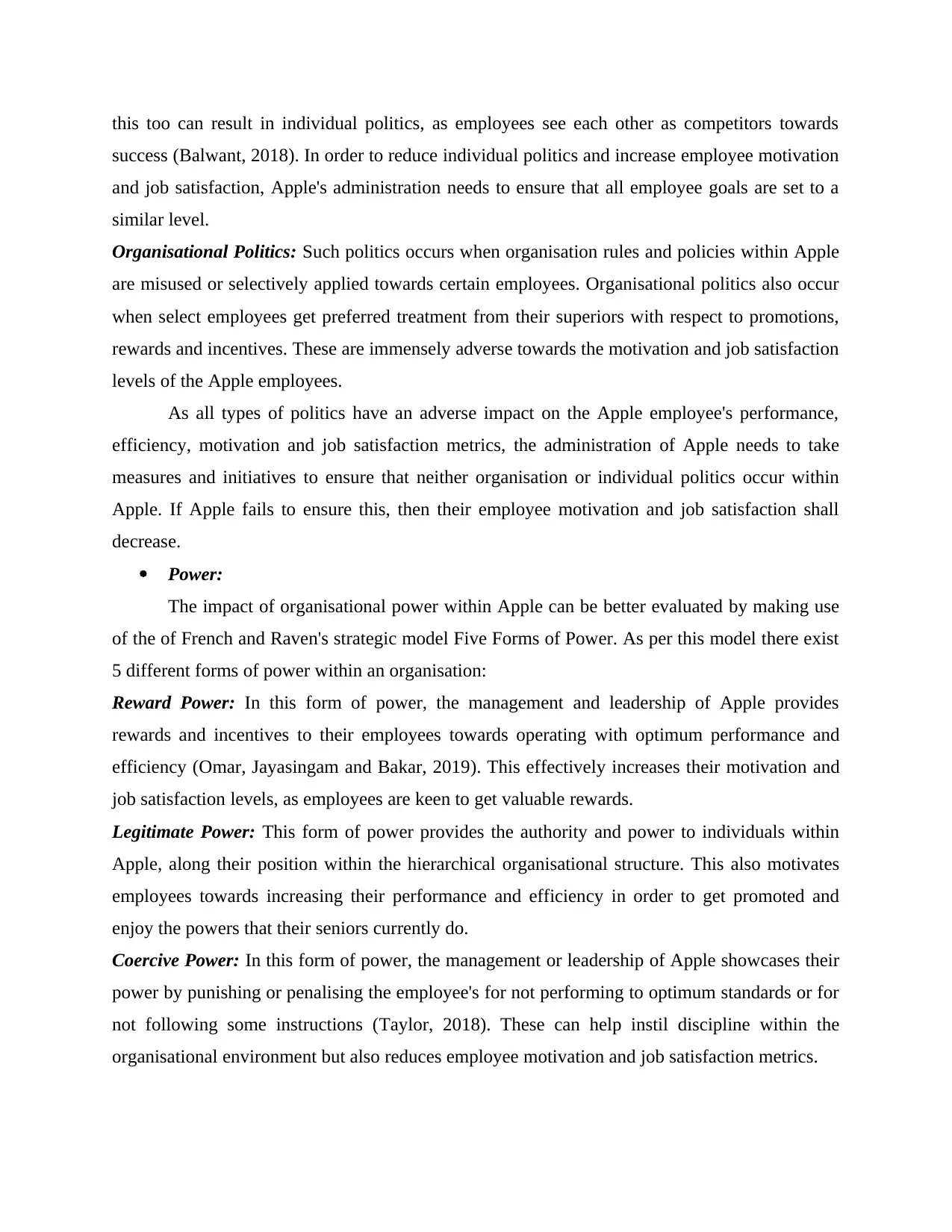
this too can result in individual politics, as employees see each other as competitors towards
success (Balwant, 2018). In order to reduce individual politics and increase employee motivation
and job satisfaction, Apple's administration needs to ensure that all employee goals are set to a
similar level.
Organisational Politics: Such politics occurs when organisation rules and policies within Apple
are misused or selectively applied towards certain employees. Organisational politics also occur
when select employees get preferred treatment from their superiors with respect to promotions,
rewards and incentives. These are immensely adverse towards the motivation and job satisfaction
levels of the Apple employees.
As all types of politics have an adverse impact on the Apple employee's performance,
efficiency, motivation and job satisfaction metrics, the administration of Apple needs to take
measures and initiatives to ensure that neither organisation or individual politics occur within
Apple. If Apple fails to ensure this, then their employee motivation and job satisfaction shall
decrease.
Power:
The impact of organisational power within Apple can be better evaluated by making use
of the of French and Raven's strategic model Five Forms of Power. As per this model there exist
5 different forms of power within an organisation:
Reward Power: In this form of power, the management and leadership of Apple provides
rewards and incentives to their employees towards operating with optimum performance and
efficiency (Omar, Jayasingam and Bakar, 2019). This effectively increases their motivation and
job satisfaction levels, as employees are keen to get valuable rewards.
Legitimate Power: This form of power provides the authority and power to individuals within
Apple, along their position within the hierarchical organisational structure. This also motivates
employees towards increasing their performance and efficiency in order to get promoted and
enjoy the powers that their seniors currently do.
Coercive Power: In this form of power, the management or leadership of Apple showcases their
power by punishing or penalising the employee's for not performing to optimum standards or for
not following some instructions (Taylor, 2018). These can help instil discipline within the
organisational environment but also reduces employee motivation and job satisfaction metrics.
success (Balwant, 2018). In order to reduce individual politics and increase employee motivation
and job satisfaction, Apple's administration needs to ensure that all employee goals are set to a
similar level.
Organisational Politics: Such politics occurs when organisation rules and policies within Apple
are misused or selectively applied towards certain employees. Organisational politics also occur
when select employees get preferred treatment from their superiors with respect to promotions,
rewards and incentives. These are immensely adverse towards the motivation and job satisfaction
levels of the Apple employees.
As all types of politics have an adverse impact on the Apple employee's performance,
efficiency, motivation and job satisfaction metrics, the administration of Apple needs to take
measures and initiatives to ensure that neither organisation or individual politics occur within
Apple. If Apple fails to ensure this, then their employee motivation and job satisfaction shall
decrease.
Power:
The impact of organisational power within Apple can be better evaluated by making use
of the of French and Raven's strategic model Five Forms of Power. As per this model there exist
5 different forms of power within an organisation:
Reward Power: In this form of power, the management and leadership of Apple provides
rewards and incentives to their employees towards operating with optimum performance and
efficiency (Omar, Jayasingam and Bakar, 2019). This effectively increases their motivation and
job satisfaction levels, as employees are keen to get valuable rewards.
Legitimate Power: This form of power provides the authority and power to individuals within
Apple, along their position within the hierarchical organisational structure. This also motivates
employees towards increasing their performance and efficiency in order to get promoted and
enjoy the powers that their seniors currently do.
Coercive Power: In this form of power, the management or leadership of Apple showcases their
power by punishing or penalising the employee's for not performing to optimum standards or for
not following some instructions (Taylor, 2018). These can help instil discipline within the
organisational environment but also reduces employee motivation and job satisfaction metrics.
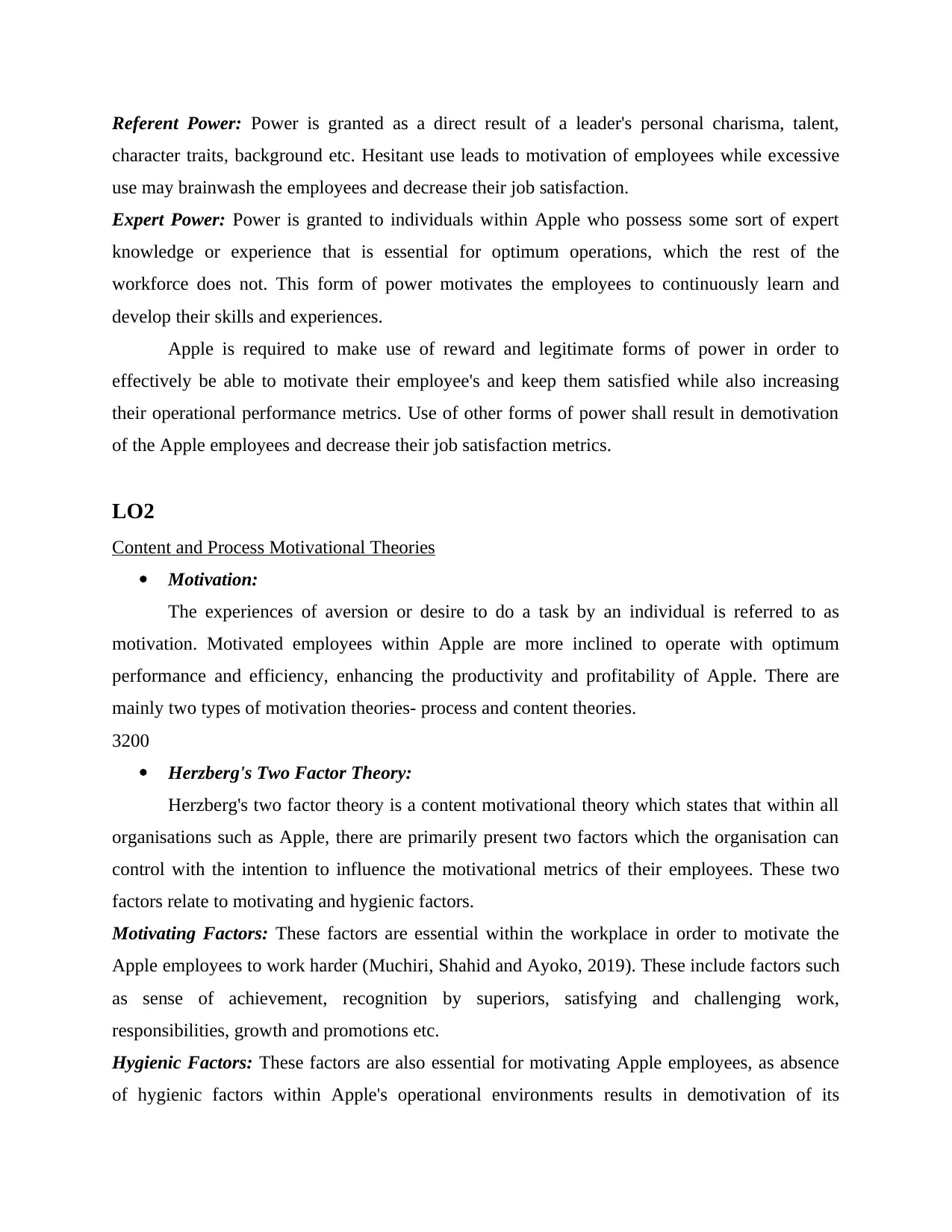
Referent Power: Power is granted as a direct result of a leader's personal charisma, talent,
character traits, background etc. Hesitant use leads to motivation of employees while excessive
use may brainwash the employees and decrease their job satisfaction.
Expert Power: Power is granted to individuals within Apple who possess some sort of expert
knowledge or experience that is essential for optimum operations, which the rest of the
workforce does not. This form of power motivates the employees to continuously learn and
develop their skills and experiences.
Apple is required to make use of reward and legitimate forms of power in order to
effectively be able to motivate their employee's and keep them satisfied while also increasing
their operational performance metrics. Use of other forms of power shall result in demotivation
of the Apple employees and decrease their job satisfaction metrics.
LO2
Content and Process Motivational Theories
Motivation:
The experiences of aversion or desire to do a task by an individual is referred to as
motivation. Motivated employees within Apple are more inclined to operate with optimum
performance and efficiency, enhancing the productivity and profitability of Apple. There are
mainly two types of motivation theories- process and content theories.
3200
Herzberg's Two Factor Theory:
Herzberg's two factor theory is a content motivational theory which states that within all
organisations such as Apple, there are primarily present two factors which the organisation can
control with the intention to influence the motivational metrics of their employees. These two
factors relate to motivating and hygienic factors.
Motivating Factors: These factors are essential within the workplace in order to motivate the
Apple employees to work harder (Muchiri, Shahid and Ayoko, 2019). These include factors such
as sense of achievement, recognition by superiors, satisfying and challenging work,
responsibilities, growth and promotions etc.
Hygienic Factors: These factors are also essential for motivating Apple employees, as absence
of hygienic factors within Apple's operational environments results in demotivation of its
character traits, background etc. Hesitant use leads to motivation of employees while excessive
use may brainwash the employees and decrease their job satisfaction.
Expert Power: Power is granted to individuals within Apple who possess some sort of expert
knowledge or experience that is essential for optimum operations, which the rest of the
workforce does not. This form of power motivates the employees to continuously learn and
develop their skills and experiences.
Apple is required to make use of reward and legitimate forms of power in order to
effectively be able to motivate their employee's and keep them satisfied while also increasing
their operational performance metrics. Use of other forms of power shall result in demotivation
of the Apple employees and decrease their job satisfaction metrics.
LO2
Content and Process Motivational Theories
Motivation:
The experiences of aversion or desire to do a task by an individual is referred to as
motivation. Motivated employees within Apple are more inclined to operate with optimum
performance and efficiency, enhancing the productivity and profitability of Apple. There are
mainly two types of motivation theories- process and content theories.
3200
Herzberg's Two Factor Theory:
Herzberg's two factor theory is a content motivational theory which states that within all
organisations such as Apple, there are primarily present two factors which the organisation can
control with the intention to influence the motivational metrics of their employees. These two
factors relate to motivating and hygienic factors.
Motivating Factors: These factors are essential within the workplace in order to motivate the
Apple employees to work harder (Muchiri, Shahid and Ayoko, 2019). These include factors such
as sense of achievement, recognition by superiors, satisfying and challenging work,
responsibilities, growth and promotions etc.
Hygienic Factors: These factors are also essential for motivating Apple employees, as absence
of hygienic factors within Apple's operational environments results in demotivation of its
⊘ This is a preview!⊘
Do you want full access?
Subscribe today to unlock all pages.

Trusted by 1+ million students worldwide
1 out of 18
Related Documents
Your All-in-One AI-Powered Toolkit for Academic Success.
+13062052269
info@desklib.com
Available 24*7 on WhatsApp / Email
![[object Object]](/_next/static/media/star-bottom.7253800d.svg)
Unlock your academic potential
Copyright © 2020–2025 A2Z Services. All Rights Reserved. Developed and managed by ZUCOL.





